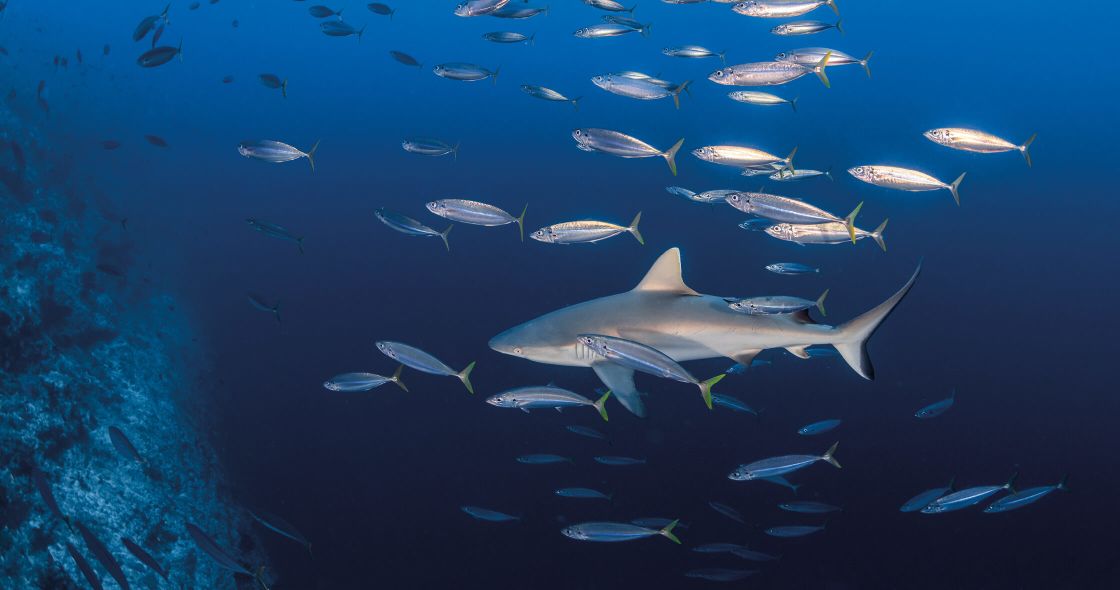
Time and tide shift with the seasons, and there’s no rushing it in the mangroves of COMO Parrot Cay.


We set out just after lunch from the jetty on the southern coast of COMO Parrot Cay, a 1,000-acre private island paradise in the Turks and Caicos Islands. We’re working hard to match the steady rhythm of our kayak paddles with Coby, our guide, who leads the way into the island’s interior.
Ahead I can see Parrot Cay’s mangrove forests coming into focus, a green canopy bursting improbably out of the bright blue salt-water, a marvel of nature’s will to survive and thrive even in an environment where most plant-life would struggle.

“Think of the mangroves like a luxury fish hotel,” Coby explains as he sets the scene for our two hour excursion. “It’s so nice in there, they’re very reluctant to leave.”
Having spent the last three nights as guests at COMO Parrot Cay, my partner and I could sympathise. But following close behind in our own double kayak, which we’ve opted for over separate kayaks or stand-up paddle-boards, we were venturing out on a guided tour through a natural wonder right in the heart of the island.
I can see individual mangrove roots now, reaching like grey, twisted fingers into the water, plunging into the white sand below. As we pull closer, they almost seem to be decaying, but Coby explains how these vibrant engines conduct a complex reverse osmosis, a natural wizardry feeding the rich green of the canopy above with a steady supply of fresh water.
These forests are the ‘lungs’ of Parrot Cay, breathing new life into this unique and fragile ecosystem one tide at a time. They can store vast amounts of carbon too, making them one of our most valuable allies in the fight against climate change.
A gentle nudge comes from Coby behind: “You won’t see anything, unless you get right up close”.
Paddling carefully to within inches of the roots, I finally get a glimpse into the sea-life hotel below. Shoals of tiny silver fish dash between dash through the maze of roots, while a mottled pufferfish makes slower progress, lazily drifting by. Look deeper still, and light from the glowing sun above flashes off blues, oranges and and golds.
There’s something so deeply soothing about watching this submarine world go by, just inches below the surface.

Coby lists the array of life we can hope to find out here. The crown jewels for him? The notoriously hard-to-spot sea turtles and sharks.
“Sharks?” my partner asks, a little nervously.
“Don’t worry,” Coby reassures, “only little ones live in the mangroves – this is their nursery. You might see infant lemon sharks, nurse sharks, or perhaps a black-tipped reef – none of them a threat to humans.”
While we keep eyes peeled for a tell-tale fin, Coby positions himself for a much more reliable sea-life encounter which is unique to these environments.
He points down to the sand just inches below us. Following his finger, I can only see circular clumps of what look like green seaweed, tendrils waving in the current. Smiling, he puts his hand into the water and slowly lifts one, before turning it over.
The underside is the unmistakable gelatinous lid of a jellyfish.
“This is a Cassiopea, better known in these parts as the ‘upside down jellyfish’. They’re well camouflaged – it pays to be out here.”
He lowers the silvery lid slowly to its original nook in the sand, now happily the wrong way up. Like the mangroves themselves, this remarkable creature has evolved a neat trick to survive in these shallow, salty waters — a symbiotic relationship with a type of algae, allowing it to photosynthesise like a plant.
As we paddle our way through the channels, and back towards the open water, Coby explains how these floating forests are not just havens for fragile marine life. They’re the guardians of the island’s shoreline, preventing erosion as the waters move in and out, preserving the powder-soft beaches that circle the island.
Their roots hold the island’s precious soils steady, while also filtering sediments and pollutants from the island’s water system, keeping it clean and clear for plants, wildlife and humans alike.
These ecosystems are so important that the locals plant them deliberately to anchor their islands in place. Coby points to loan shoots striking out in the middle of a channel: baby mangroves. Soon they will spread their powerful fingers into the sand and anchor themselves, and around them another submarine kingdom will soon teem with life.
He explains how the coral reefs and the mangroves together are nature’s defences, keeping the island protected in the face of hurricanes. Sometimes, however, the storms can be strong enough to scatter even these deep-rooted forests.


“But that’s the start of something new – the scattered mangroves form a new forest, and with it, new life.”
It’s a reminder that in nature, as in life, it pays to be flexible.
Stray droplets of rain herald a coming shower. It’s time to turn for home. As we take in the mangrove forest one last time, a rainbow flickers between the tips of its leaves and the pregnant rain clouds above. A beautiful parting gift.
But as we’ve been distracted by the mangroves’ swansong, Coby has stayed on high alert. He points suddenly between our kayaks.
Below us a dark shape flashes past. It’s a green sea turtle, once endangered here, but now thankfully making a comeback thanks to a concerted conservation campaign.
As it heads home to the mangroves, that hotel beneath the waves, it pokes its small, scaled head briefly above the waves. It holds our gaze for all of two seconds, but the encounter is enough time to return the nod: one happy hotel guest to another.

Contact our team on the ground to discover the heart of COMO Parrot Cay.





